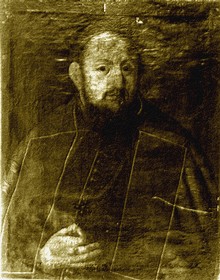Family Mankovics was old but poor family, but with the long tradition of priesthood, which feature Greek Catholic priest has been passed down from father to son. The first written records of this family member is about Manykovics Tomas, who was born around 1650 and was a priest in Blazov. His grandson George became bishop of Mukachevo.

Born in a family of John Mankovics in 1705. After graduating high school in Levoca he continued his theological studies in the seminary Adalbertinum in Trnava. This seminar has been generously supported by the Church, and thus to study and youths from poor families. George there was ordained a priest in 1729. He later became a member of the monastic order The Order of Saint Basil the Great (OSBM - Ordo Sancti Basili Magni). After graduation he went to Mukachevo, where he served as secretary to the Bishop of Mukachevo Simon Olysavszky. After the death of Bishop Olysavszky in 1738 George was appointed in his place and took the name Georgius Gregorius Blazovky (Heorhij Havrilij Blazovskij). Blažovsky name given by a native of the village, along the lines of its predecessor. According to history he is known as the critical bishop who criticized the luxurious life of the clergy and his lack of interest in the poor believers. In the position of bishop of the Eparchy of Mukachevo he worked only briefly, only till 1742. In December 1742 he went to the monastery in the town Malij Bereznij, to flee before plague, but there he fell ill and died He is buried in Mukachevo.

He was the nephew of Bishop Blazovsky. Born in the family of priest Michael Mankovics and his wife Anastasia Hodobay in 1785. Basic education received at home, his study continued in the town Sabinov and he completed basic education in the town Levoca In 1800 he was sent to Uzhhorod, so here studying at theological seminary, to continue the tradition of priestly family. Michael was not a good student, more devoted himself to his hobby, which has been drawing and painting. After two years of study with weak results, The Diocese of Mukachevo, through the intercession of Bishop Bacinsky, sent Michael to study of painting at the Vienna Academy and granted him a small stipend. Michal was lucky to have lived in Vienna his uncle, who supported him in the study and helped him financially. However, after two years Michael‘s uncle got married and moved to Rijeka. Young Michal remained unattended and increasingly devoted himself to pleasures of the big city as a study. He finally decided to leave Vienna and try his luck in the world.
He has traveled around the great cities of the former Austro-Hungarian monarchy. Longer abstained in Cracow, then he went to Lviv, where he lived for about three years. Here he decided to travel to Russia. But it was in the time of Napoleon's expedition to Russia, and so Michael was in Kiev arrested as a spy. After several months in prison the court found him to be innocent, but had to leave Russia. He returned to Lviv, but his decision to travel Russia has not changed. Disguised as a monk finally made it to Moscow. Misery and suffering of the Russian people, what he saw on his journey, it has affected the whole rest of his life. At the time of Napoleon's defeat he was already again in Vienna. His life now here was very poor. Through their relatives he begged the representatives of Eparchy of Mukachevo to be able to return to their services. Finally, he would be allowed to do it in 1813, but his life has not improved.

A change occurred only after he married the pretty, young widow, former wife of a priest from Zemplínske Hradište, with Mary Danilovich, native Bacinsky. Although Bishop Bacinsky was dead in this time, his extended family still had a great influence on church life of The Eparchy of Mukachevo. Michael was appointed as a painter of The Eparchy of Mukachevo. Next Michael received large orders for religious paintings and get paid well for it. The last years of his life Michael lived in the village Slovinky, but before his death, already seriously ill, he returned to Uzhgorod, where he died in 1853. Michael Mankovics belonged together with Joseph Zmij-Miklosik the most important painter of religious paintings for the Greek-Catholic Church. It is said that in every church of the Eparchy of Mukachevo was at least one Picture by Michael Mankovice. He was also one of only the few religious painters, who in his work dealt with the secular themes. Michal for his secular paintings used mainly scenes from Greek mythology.
Sources: Dr. Beszkid Mihály Miklós ,: Mankovics, Budapest, 1914
-------------Janko Alexy: The fate of Slovak artists, Bratislava, 1948
English correction: Jan Bayus